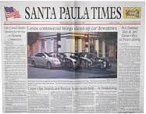SOFIA: Rotary hosts Stratospheric
Observatory for Infrared Astronomy pilot
April 08, 2015
By Peggy Kelly
Santa Paula News
When most people hear SOFIA they think of the glamorous actress with the thick Columbian accent that plays the trophy wife on the hit TV comedy “Modern Family” but there’s a bigger star out there than Sofia Vergara.
Think SOFIA, as in a Boeing 747SP originally built in 1977 that was retrofitted to become a flying laboratory carrying a 100-inch diameter telescope (2.5 meters).
This SOFIA took its first science flight in December 2010 — the proposed lifetime of its mission is 20 years — and its seven first-generation Instruments include cameras, spectrometers and a high-speed photometer.
Also aboard is pilot Manny Amtimisiaris who told the Santa Paula Rotary at a recent meeting about SOFIA — a.k.a. Stratospheric Observatory for Infrared Astronomy — and his career at her controls.
A retired Air Force Lt. Colonel, Manny had storied experience before he became part of SOFIA’s crew.
“I have the most extraordinary job,” said Manny, “I enjoy going to work everyday!”
Although the Space Shuttle program has ended those based at Edwards Air Force Base’s NASA Armstrong Flight Research Center are still headed for space: originally christened the Clipper Lindbergh in honor of Charles Lindbergh, the SOFIA is a joint project of NASA and the German Aerospace Center (DLR).
NASA “writes the stories of the future today” through its space programs and SOFIA is a wonder: according to NASA the primary science objectives of SOFIA are to study the composition of planetary atmospheres and surfaces; to investigate the structure, evolution and composition of comets; to determine the physics and chemistry of the interstellar medium; and to explore the formation of stars and other stellar objects.
Manny, a native of New Jersey, first was a navigator and became a commercial pilot when he retired from the Air Force, although he remained a Reserve.
He eventually wound up with SOFIA, which each year also travels to the Ice Cap to map and measure the ice.
Manny said the changes are dramatic: “I’m not political about climate change, I don’t know why it is changing but it is changing. ”
Whether buzzing glaciers or working with fire services to direct where the hottest area of the burn is for water tender drops, Manny said NASA aircraft is also used to determine how much movement results from seismic activity.
But SOFIA is the main program, “One of a kind” that even belittled the conventional ideas of aircraft: “They had a series of progressive flights to see if this dog whistle would fly,” when the hold was opened for observatory use.
SOFIA flights start two hours before sunset and end at sunrise; with its 34,000-pound telescope and another equipment SOFIA has been involved in recording interstellar medium physics and star formation, planet formation in nearby star systems, determining the origin and evolution of biogenic atoms, molecules, and solids, composition and structure of comets, planetary atmospheres and rings, star formation, dynamics, and interstellar medium chemistry of other galaxies as well as the dynamic activity in the center of the Milky Way.
Manny said an education program is an important component of the SOFIA mission that involves taking a teacher up with the crew, classroom study and then a visit to Edwards Air Force Base.
And speaking of visits Manny said it was a thrill to give former Apollo 13 Astronaut Fred Haise — only one of 24 humans to have flown to the moon — a tour of SOFIA.
Although NASA receives just a fraction of government funding, at times programs such as SOFIA have been threatened at home.
But Manny said SOFIA remains a rock star: “I landed once in Germany on Aviation Day … the Germans love aviation and there were 200,000 people at the airport — and I think I spoke to all of them!”


